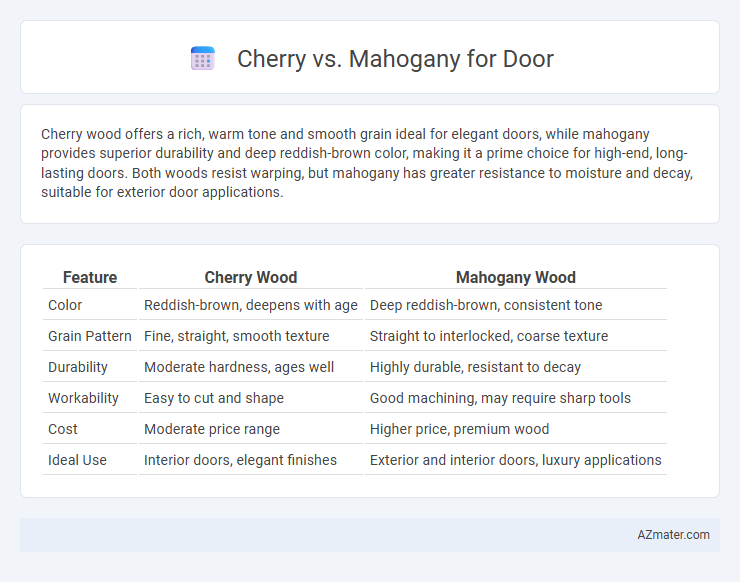Cherry wood offers a rich, warm tone and smooth grain ideal for elegant doors, while mahogany provides superior durability and deep reddish-brown color, making it a prime choice for high-end, long-lasting doors. Both woods resist warping, but mahogany has greater resistance to moisture and decay, suitable for exterior door applications.
Table of Comparison
| Feature | Cherry Wood | Mahogany Wood |
|---|---|---|
| Color | Reddish-brown, deepens with age | Deep reddish-brown, consistent tone |
| Grain Pattern | Fine, straight, smooth texture | Straight to interlocked, coarse texture |
| Durability | Moderate hardness, ages well | Highly durable, resistant to decay |
| Workability | Easy to cut and shape | Good machining, may require sharp tools |
| Cost | Moderate price range | Higher price, premium wood |
| Ideal Use | Interior doors, elegant finishes | Exterior and interior doors, luxury applications |
Introduction to Cherry and Mahogany Doors
Cherry doors showcase a rich, reddish-brown hue that deepens with age, offering a warm and elegant aesthetic for interior spaces. Mahogany doors are prized for their deep, reddish-brown color combined with exceptional durability and resistance to decay, making them ideal for both interior and exterior applications. Both woods provide a luxurious finish and fine grain patterns, but mahogany typically offers greater longevity and moisture resistance.
Key Differences Between Cherry and Mahogany Wood
Cherry wood features a rich reddish-brown hue that deepens with age, while mahogany offers a deeper, reddish-brown to dark brown color with a more consistent grain pattern. Cherry is softer and more prone to dents and scratches compared to the denser, harder mahogany, which provides enhanced durability for high-traffic door applications. The fine, smooth texture of cherry contrasts with mahogany's coarser grain, influencing both the aesthetic appeal and finish techniques used on doors.
Appearance and Grain Patterns Comparison
Cherry wood exhibits a rich, warm reddish-brown hue that deepens with age, showcasing a smooth, fine grain pattern often featuring subtle, flowing waves. In contrast, Mahogany displays a deeper, more consistent reddish-brown color with a straight, interlocked grain that offers a uniform texture and a slightly coarse feel. The unique grain patterns of Cherry provide a more dynamic and visually complex look, while Mahogany's uniformity results in a classic, elegant appearance ideal for formal door designs.
Durability and Strength: Cherry vs Mahogany
Mahogany offers exceptional durability and strength, making it highly resistant to warping and decay, which is ideal for exterior doors exposed to harsh weather. Cherry wood, while moderately strong and durable, is more prone to dents and scratches compared to mahogany, better suited for interior doors with less wear. The dense grain and natural oils in mahogany provide superior longevity and structural integrity, outperforming cherry in high-traffic or heavy-use door applications.
Cost Considerations for Cherry and Mahogany Doors
Cherry doors typically cost more due to the wood's fine grain and rich reddish-brown hue, which requires careful harvesting and longer aging periods. Mahogany doors offer a more affordable option with excellent durability and resistance to decay, making them cost-effective over time. When choosing between cherry and mahogany doors, consider not only the initial price but also long-term maintenance expenses and resale value.
Maintenance and Care Requirements
Cherry doors require regular polishing and protection from direct sunlight to prevent fading and maintain their rich reddish-brown hue, while their fine grain makes cleaning straightforward with mild soap and water. Mahogany doors are more resistant to moisture and decay, demanding less frequent refinishing but benefit from periodic sealing to preserve their deep, warm tones and prevent drying or cracking. Both wood types need careful attention to humidity control to ensure longevity and optimal appearance over time.
Environmental Impact and Sustainability
Cherry wood is a moderately sustainable choice for doors, as it grows at a faster rate compared to mahogany, allowing for more frequent harvesting cycles. Mahogany, often sourced from tropical rainforests, poses significant environmental concerns due to deforestation and habitat loss, despite its durability and timeless appeal. Selecting cherry wood supports better forest management practices and reduces ecological damage, making it a more environmentally responsible option for door construction.
Finishing Options: Stain and Paint Compatibility
Cherry wood offers a smooth, fine grain that accepts stains exceptionally well, enhancing its rich reddish-brown tones while maintaining a natural look ideal for clear or tinted finishes. Mahogany provides a more uniform texture and deep reddish-brown color that responds well to both stains and paints, allowing for versatile finishing options from natural wood highlights to solid-color paint applications. Both woods are compatible with water-based and oil-based stains and paints, but cherry's finer grain tends to produce a more consistent sheen, while mahogany's tighter grain ensures durability and color retention under various finishing treatments.
Best Applications for Cherry vs Mahogany Doors
Cherry wood doors offer a smooth grain and warm reddish hue, making them ideal for elegant interior doors in traditional or transitional homes. Mahogany doors provide exceptional durability and rich, deep color, perfect for exterior doors exposed to weather or high-traffic entryways requiring long-lasting strength. Both woods excel in craftsmanship, but cherry is preferred for refined indoor aesthetics while mahogany suits robust, weather-resistant applications.
Which Wood Is Right for Your Door?
Cherry wood features a smooth texture and rich reddish-brown hue that deepens with age, offering an elegant, classic appearance ideal for traditional door designs. Mahogany provides exceptional durability and a deep, warm color with a striking grain pattern, making it suitable for exterior doors exposed to varying weather conditions. Choosing between Cherry and Mahogany depends on your preference for color aging, grain detail, and the door's exposure to environmental elements.

Infographic: Cherry vs Mahogany for Door
 azmater.com
azmater.com